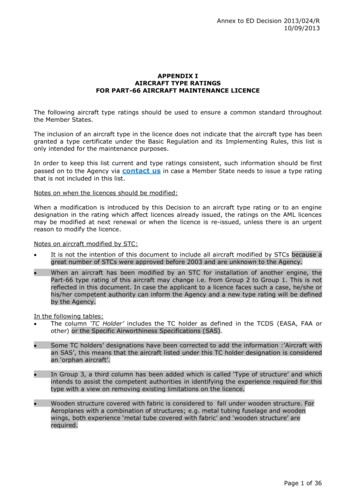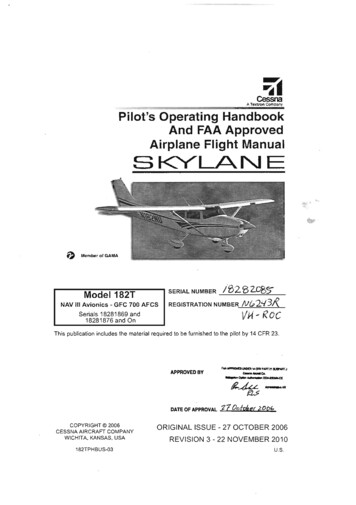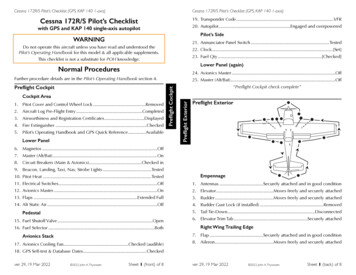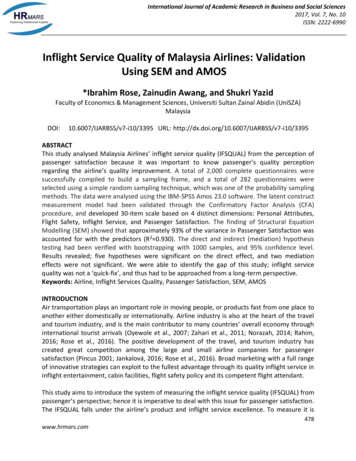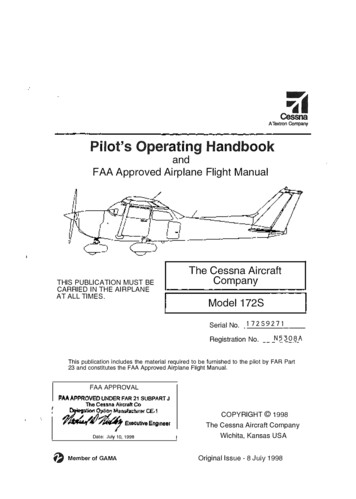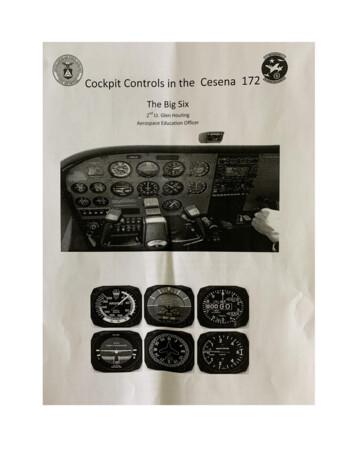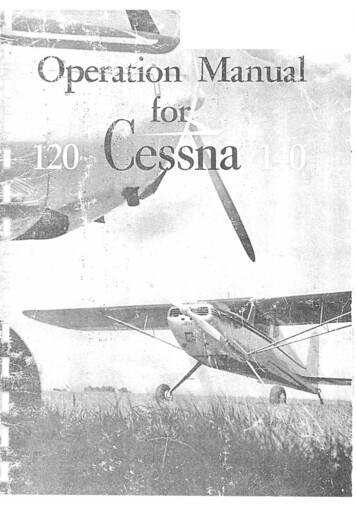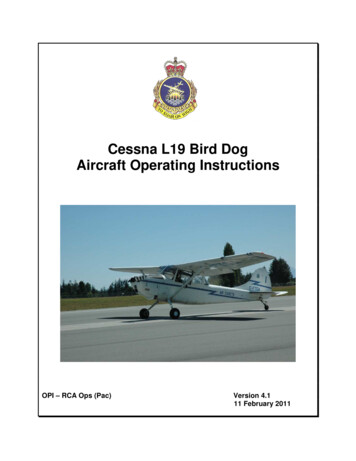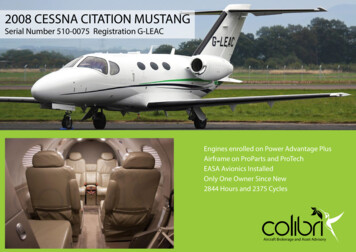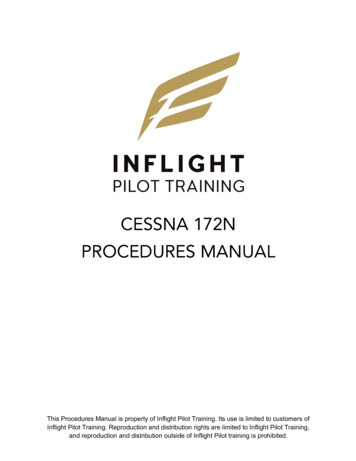
Transcription
CESSNA 172NPROCEDURES MANUALThis Procedures Manual is property of Inflight Pilot Training. Its use is limited to customers ofInflight Pilot Training. Reproduction and distribution rights are limited to Inflight Pilot Training,and reproduction and distribution outside of Inflight Pilot training is prohibited.
Cessna 172N ProceduresPre-Maneuver FlowSeat Belts .SecureFuel . .OnMixture . . .RichLanding Light . .OnEngine Gauges . .Green/NormalSlow Flight – Airplane Flying Handbook (AFH) 4-3Clearing Turns CompleteAltitude .Minimum 1500’ AGLManeuverPower . 1500 RPMCarburetor Heat . OnFlaps .Extend in Increments to 30 Airspeed Pitch to maintain above stall hornAltitude .Increase power as necessary to maintainRecovery – if stall horn sounds, buffet occurs, or instructor directs.Power . .FullCarburetor Heat . . .OffFlaps Retract in increments (10 increments as airspeed builds)TolerancesHeading . . /- 10 Altitude . . . /- 100 ft.Airspeed . .Above stall hornSteep Turns – 360 left and right – AFH 9-2Clearing Turns CompleteAltitude .Minimum 1500’ AGLReference Point .Landmark near horizonManeuverPower . .»2300 RPMAirspeed 90 KTSDuring Turn Slight power increaseTolerancesHeading . . /- 10 Altitude . . /- 100 ft.Airspeed . . . /- 10 KTSBank Angle . . .45 1st Edition, August 20181
Power-Off Stall (Approach Configuration) – AFH 4-8Clearing Turns .CompleteAltitude An altitude allowing full recovery by 1500’ AGLManeuverPower .1500 – 1600 RPMCarburetor Heat . .OnFlaps . Extend in Increments to 30 Airspeed . . .Pitch and Trim for 65 KTSAltitude Establish descent, choose an altitude to initiate the stallRecoveryPitch .Lower pitch, reducing elevator pressure, then back to climb attitudeAilerons . . Neutral, then level the wingsRudder . .Control yawPower . .FullCarburetor Heat . .OffFlaps .1st Notch immediately, 2nd Notch with Positive ROC, 3rd Notch at 60 KTSTolerancesHeading . . . /- 10 Bank Angle . . .20 maximumPower-On Stall (Takeoff/Climb Configuration) – AFH 4-9Clearing Turns CompleteAltitude An altitude allowing full recovery by 1500’ AGLManeuverPower .1500 RPMAltitude .Maintain levelAirspeed .Vr or Vy, as desiredPower .2300 RPM minimum - FullRecoveryPitch .Lower pitch, reducing elevator pressure, then back to climb attitudeAilerons . . Neutral, then level the wingsRudder . .Control yawPower . .FullTolerancesHeading . . . /- 10 Bank Angle . . .20 maximumAccelerated Stall (Commercial/CFI) – AFH 4-10Clearing Turns CompleteAltitude An altitude allowing full recovery by 1500’ AGL1st Edition, August 20182
ManeuverThrottle. . 1500 RPMAltitude .Maintain levelBank Angle .45 , increase back pressure to reach stallRecoveryPitch .Lower pitch, reducing elevator pressure, then back to climb attitudeAilerons . . Neutral, then level the wingsRudder . .Control yawPower . .FullSecondary Stall (CFI) – AFH 4-10Clearing Turns .CompleteAltitude An altitude allowing full recovery by 1500’ AGLManeuverThrottle. .1500 RPMFlaps . Extend in Increments to 30 Airspeed . . .Pitch and Trim for 65 KTSAltitude Establish descent, choose an altitude to initiate the stallStall Indication .Release back pressure, then immediately increase abruptlyRecoveryPitch .Lower pitch, reducing elevator pressure, then back to climb attitudeAilerons . . Neutral, then level the wingsRudder . .Control yawPower . . .FullFlaps .1st Notch immediately, 2nd Notch with Positive ROC, 3rd Notch at 60 KTSElevator Trim Stall (CFI) – AFH 4-12Clearing Turns .CompleteAltitude An altitude allowing full recovery by 1500’ AGLManeuverThrottle. .1500 RPMFlaps . Extend in Increments to 30 Airspeed . .Pitch and Trim for 65 KTSAltitude Establish descent, choose an altitude to initiate the stallPower .Full, simulate go-aroundRecoveryPitch .Lower pitch, reducing elevator pressure, then back to climb attitudeAilerons . . Neutral, then level the wingsRudder . .Control yawPower . FullFlaps .1st Notch immediately, 2nd Notch with Positive ROC, 3rd Notch at 60 KTSCrossed Control Stall (CFI) – AFH 4-11Clearing Turns .Complete1st Edition, August 20183
Altitude An altitude allowing full recovery by 1500’ AGLManeuverThrottle. .1500 RPMDescent . 65 KTSEnter Turn Increase Rudder in Direction of Turn, Increase Opposite Aileron, Maintain Elevator Back PressureRecoveryPitch .Lower pitch, reducing elevator pressure, then back to climb attitudeAilerons . . Neutral, then level the wingsRudder . .Control yawPower . FullChandelles – AFH 9-5Clearing Turns .CompleteAltitude . . An altitude of at least 1500’ AGLReference Point SelectedManeuverPower .2300 RPMAirspeed . .95 KTSChandelle . .CompleteTolerancesHeading . . . /- 10 Bank Angle . . .30 maximumAirspeed . Just above stallLazy Eights – AFH 9-6Clearing Turns .CompleteAltitude . . An altitude of at least 1500’ AGLReference Point SelectedManeuverPower .2300 RPMAirspeed . .95 KTSLazy Eight . .CompleteTolerancesHeading . . . /- 10 Bank Angle . . .30 maximumAirspeed . . . /- 10 KTSAltitude . . /- 100’ from entry altitudeSteep Spirals – AFH 9-4Clearing Turns .CompleteAltitude . . An altitude allowing 3 complete turns by 1500’ AGL1st Edition, August 20184
Reference Point SelectedManeuverPower . .Idle abeam pointSteep Spiral . .Complete 3 turnsAirspeed . .65 KTSTolerancesHeading . . . /- 10 Bank Angle . . .60 maximumAirspeed . . /- 10 KTSAltitude . . .Complete by 1500’ AGLEights on Pylons – AFH 6-14Clearing Turns .CompleteAltitude . . Pivotal altitude calculated/selectedReference Points. SelectedEmergency Field. SelectedManeuverPower .2300 RPMAirspeed . .95 KTSEights on Pylons . . . .CompleteTolerancesHeading . .45 entry to first pylonBank Angle . . .As necessaryAirspeed . . . /- 10 KTSAltitude . . . .Begin and end at pivotal altitudeTurns Around a Point – AFH 6-8Clearing Turns .CompleteAltitude . . . 1000’ AGLReference Point. SelectedEmergency Field. SelectedManeuverPower .2300 RPMAirspeed . .95 KTSTurn Around Point. . . .CompleteHeading . . . /- 10 Bank Angle . . .45 maximumAirspeed . /- 10 KTSAltitude . . . /- 100’S-Turns Across a Road – AFH 6-10Clearing Turns .CompleteAltitude . . . 1000’ AGL1st Edition, August 20185
Reference Point. SelectedEmergency Field. SelectedManeuverPower .2300 RPMS-Turn . . . .CompleteAirspeed . .95 KTSHeading . . . /- 10 Bank Angle . . .45 maximumAirspeed . . . /- 10 KTSAltitude . . . /- 100’1st Edition, August 20186
Take-Off’sNormal Take-Off .No FlapsSoft Field Take-Off .10 FlapsShort Field Take-Off .55 KTS till Obstacle Clearance, 10 FlapsLandingsNormal Landing . 65 KTS, 30 FlapsSoft Field Landing . 65 KTS, 30 FlapsShort Field Landing 60 KTS, 30 FlapsPower-Off 180 Approach . 65 KTS, Flaps as required OR with Forward Slip, MAX 20 Flaps1st Edition, August 20187
Traffic Pattern – AFH CH. 7Upwind:Downwind:Flaps UpFull Power70-80 KTSVy – 73 Vx – 591000’ AGL2300 RPMBrief Landing:RunwayWindApproach SpeedTouchdown/Aim PointAbeam TD:Carb Heat1500 RPM85 KTS10 FlapsFinal:30 Flaps65 KTSBase:20 Flaps75 KTS1st Edition, August 20188
Engine Failure Procedure – AFH 8-25, 26The engine failure procedure is intended to provide the student with a basic procedure in order to correctly set up theaircraft for a power off approach to the emergency landing site. Not included in this procedure are the necessaryprocedures and checklists to troubleshoot the engine and secure the engine. These will be found in the aircraft POHas well as the Inflight iPad checklists.WIND1Proceed directly toKEY POSITION atBest Glide. Completechecklists andcommunicate asaltitude allows. Aviate,Navigate,Communicate.Emergency landing site,selected due to wind,obstacles, size, terrain.KEY POSITION¼ - ½ mile abeam1000’ AGL (est.)32Spiral asnecessary toarrive at KeyPosition.Depart Key Position andexecute the power offapproach, using flapsand forward slip asnecessary to simulatelanding at emergencysite.1st Edition, August 20189
Instrument Approach ProcedurePrior to the Approach:Approach. .BriefedChecklists. Completed as necessaryOn Initial Approach Segment or Downwind/Base VectorThrottle. .2300 RPMAirspeed. CruiseApproaching Major Descent Point (1/2 Scale on GS or 2 NM to FAF)Airspeed. .90 KTSIntercepting Major Descent Point (GS/FAF)Throttle. .1700 RPMCarb Heat OnFlaps. 10 Pitch. 2.5 DownAirspeed. .80 - 85 KTSBriefing the ApproachWEATHER – ATIS/Automated WeatherINSTRUMENTS – Set as necessary.RADIOS – Set as necessaryENVIRONMENT – Brief the approachBrief the approach from Top to BottomHeader - Verify Name, Type, and Runway of the approach. Discuss the notes and frequencies and note any changesas necessary. Verify airport lighting. Tune and ID frequencies. Verify airport elevation and TDZE.Planview – Brief current location relative to the airport, IAF, approach segments to the airport, and any procedureturns. Minimum Safe Altitude for the area. Brief runway position relative to Final Approach Course. Is circlingrequired?Profile – Brief fixes, altitudes, and minimums.Missed Approach – Brief the FULL missed approach. The first 2 steps should be memorized.1st Edition, August 201810
This Procedures Manual is property of Inflight Pilot Training. Its use is limited to customers of Inflight Pilot Training. Reproduction and distribution rights are limited to Inflight Pilot Training, and reproduction and distribution outside of Inflight Pilot training is prohibited. CESSNA 172N PROCEDURES MANUAL
